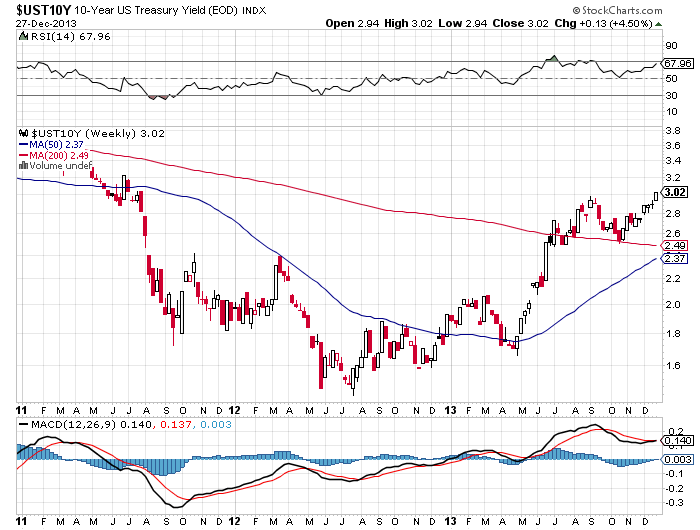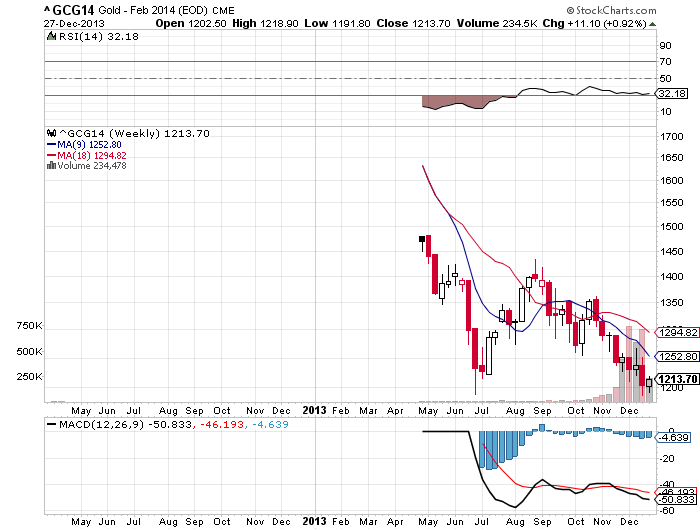I have written extensively about gold, silver, interest rates, bonds and inflation in the recent past. I always find people respond in a manner that exposes their personal vulnerabilities or deficiencies. Most of the comments, if I can get beyond the initial personal bashing and name calling, I usually can read between the lines in terms of what is the real issue behind the animosity. Some are very intelligent points of view, and I truly appreciate them because they show me that there is hope out there and what I do has an audience that appreciates the work I do. The other is in total denial to the reality of what is happening and what the future consequences can be with such unsustainable monetary policies in place.
With that in mind, I will share my perspective and review the following facts that seem to be potentially major issues as we move forward into 2014 and beyond.
- US Ten Year Treasury Yield
On the last Friday of 2013, the US Ten Year Treasury Yield closed at a new high of 3.02%. This sets up the market to challenge the 2011 levels of 3.40% to the 3.80% yield. If we look at the chart below, we can clearly see an uptrend has developed and it is strongly supported by the market levels moving substantially higher above the 50 and 200 day moving averages.
- US 30 Year Treasury Yield
The US 30 Year Treasury Yield closed at a 3.94% yield. This sets the market to test and challenge the 2011 highs of 4.4% to the 4.75% yield. With the long-term bond substantially above the 50 and 200 day moving averages, we can clearly come to the conclusion that the trend is much higher for long and short-term bond yields and much lower prices – (the inverse relationship to price).
What is the consequence of higher interest rates to the economy globally?
I recently made the following comment: “As interest rates rise, and in particular in the 30 year bond, the Feds have to use extreme caution as to how much and how fast they implement their “Tapering” strategies without causing another economic crisis of global proportions that would surpass the 2008 financial crisis by causing the yield on the long end of the bond market to rise sharply.”
- INFLATION
A heated argument among political leaders and economists is whether the world economies face a serious risk of inflation or even hyperinflation with rising interest rates. This is in the face of the Fed increasing their balance sheet (leverage), and maintaining an artificial zero interest rate environment allowing them to continue to finance their debt as they see fit.
In a recent report for National Affairs, John H. Cochraine made the following observations; “But these questions miss a grave danger. As a result of the federal government’s enormous debt and deficits, substantial inflation could break out in America in the next few years. If people become convinced that our government will end up printing money to cover intractable deficits, they will see inflation in the future and so will try to get rid of dollars today – driving up the prices of goods, services and eventually wages across the entire economy. This would amount to a “run” on the dollar. As with a bank run, we would not be able to tell ahead of time when such an event would occur. But our economy will be primed for it as long as our fiscal trajectory is unsustainable.”
He continued, “The key reason serious inflation often accompanies serious economic difficulties is straightforward: Inflation is a form of sovereign default. Paying off bonds with currency that is worth half as much as it used to be is like defaulting on half of the debt. And sovereign default happens not in boom times but when economies and governments are in trouble.”
If we were to see such a financial chaos it would possibly ignite recessionary fears once again and even plunge world markets into a deeper more contracted recession worse than the 2008 crisis. There is nothing that the Fed can do at this point as they have run out of ammunition with interest rates at the bottom of the barrel.
All conventional wisdom regarding inflation seem to embrace and find comfort on the idea that the Fed will take care of the problem or that they have it under control. The real fear behind this concept is whether the Fed actually can or have the ability to solve this problem – or have they lost control?
John remarked: “Interest rates are very low, but they are likely to rise. An increase in interest rates could also bring on inflation today, compounding the inflationary effect of a potential debt crisis through a very similar mechanism.
Just how low are today’s rates? The one-year rate is now 0.2%; the ten-year rate is about 2%, and the 30-year rate is only 4%. We have not seen rates this low in the post-war era. Furthermore, inflation is still running at around 2-3%, depending on exactly what measure of inflation we choose. If an investor lends money at 0.2% and inflation is 2%, he loses 1.8% of the value of his money every year. Such low rates are therefore unlikely to last. Sooner or later, people will find better things to do with their money, and demand higher returns to hold Treasury debt.”
What role does gold have in this scenario?
If we take a look at the technical picture in gold and silver, we can clearly see that prices in gold have been in a downtrend since September of 2012, when prices were trading in the low to mid 1400s.
The deep correction since the highs of 1900s were made in April 2011, has been perpetuated by the relentless naked short selling, precipitated by central bank manipulation. This has obviously been done in order to preserve the integrity of a decaying currency and a malfunctioning monetary system. With the record levels of debt to GDP, the reality of higher interest rates, the US economy is in the threshold of imploding into another recession.
Technical pundits are looking for gold to continue to decline to new lows. The $1,000 per oz seems to be the technical target. When you consider the risk/reward ratio at these levels, it does not make sense to be short for $150 or $200 to the downside as opposed to the upside profit potential of more than $1,000 to $2,000 conservatively.
In my last report I made the following comments regarding gold: “The gold and silver markets are entering a very strong cyclical time when a multi-year cyclical low is possible. The gold and silver markets are on track from the overall decline of the late-August period into the late December time frame and for a 2 month decline from October 28, into the late December time frame. The next time frame comes into play on Dec. 23/24 where we can expect that a major bottom is most likely. The market has rallied more than $12 since to close at $1214 on Friday December 27, increasing the probabilities that a bottom has been completed as expected into this time frame. This rally should last approximately 30 days.
Let’s take a look at the gold futures (paper) markets and see what we can anticipate for next week of trading.
- GOLD
The February gold futures contract closed at 1214 . The market closing below the 9 MA (1253) is confirmation that the trend momentum is bearish. A close above the 9 MA would negate the weekly bearish short-term trend to neutral.
With the market closing below the VC Weekly Price Momentum Indicatorof 1216, it confirms that the price momentum is bearish. A close above it would negate the bearish signal to neutral.
Cover short on corrections at the 1212 to 1211 levels and go long on a weekly reversal stop. If long, use the 1211 level as a Stop Close Only and Good Till Cancelled order. Look to take some profits on longs, as we reach the 1217 and 1221 to levels during the week.
The information in the Market Commentaries was obtained from sources believed to be reliable, but we do not guarantee its accuracy. Neither the information nor any opinion expressed therein constitutes a solicitation of the purchase or sale of any futures or options contracts




